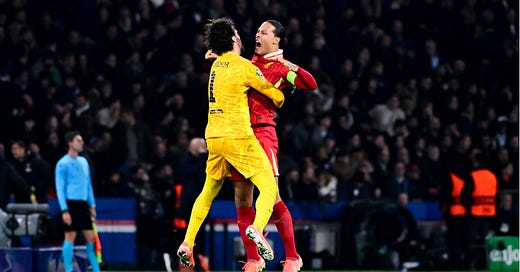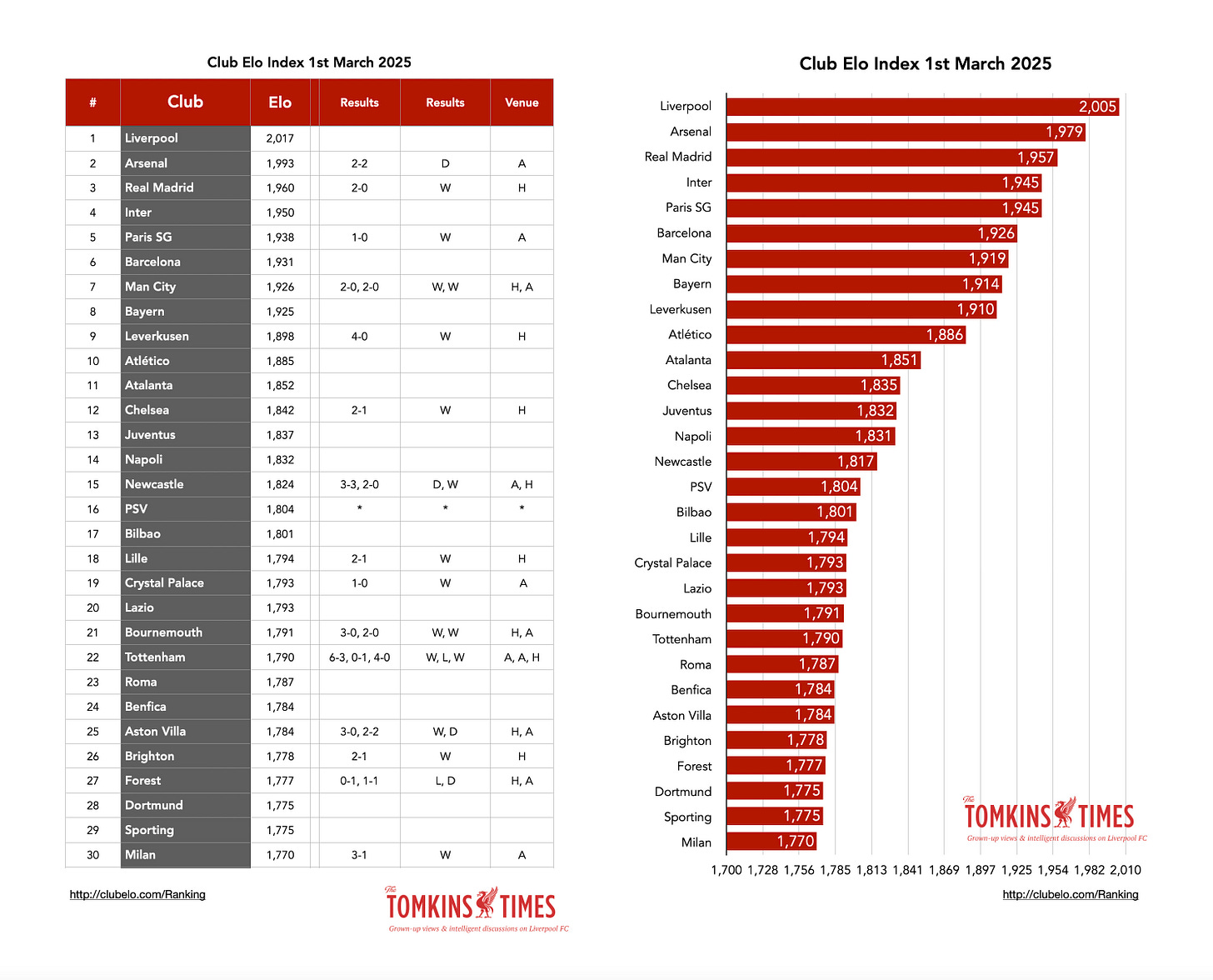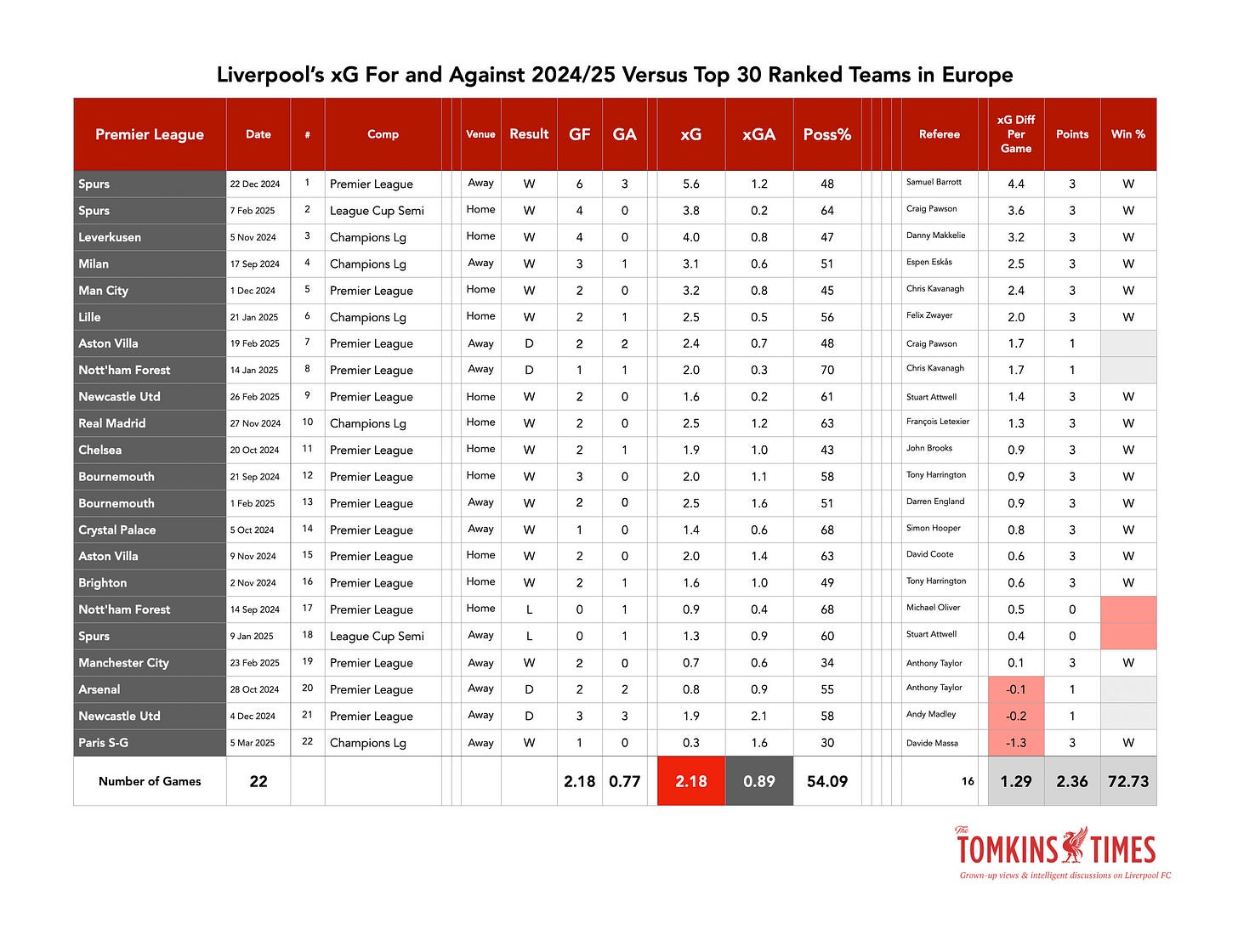“Liverpool Haven’t Played Anyone Good Yet” But Average '90-Point Season' Against Europe’s Top 30
🔥 22 Games, 2.4ppg, 48 goals for, 17 against, 73% win-rate 🔥
Excluding the reserves and kids who played at PSV in a dead rubber, Liverpool, currently ranked #1 in the Club Elo Index of European football (by some margin), have played 22 games against teams ranked in the 29 places directly below.
They have won 16, drawn four, lost two – a staggering return.
If the win vs PSG (which increased the Reds’ Elo score since I parsed the data on March 1st) was due mainly to Alisson’s brilliance, it’s probably the only time it’s been needed all season.
That’s an insane 72.7% win percentage.
Of the two lost, one was at the start of the season directly after an international break to a surprisingly effective Notts Forest, and the other was a mere first leg semi at Spurs, that saw yet another farce from the execrable Stuart Attwell to allow the player who should have been sent off to score, before the 4-0 return-leg win.
That’s 2.36ppg, or a 90-point season, when playing *only* the 30 best teams in Europe. And 22 is a good sample size to extrapolate from, with 11 at home and 11 away. (This article counts all cup games as 0, 1 or 3 points.)
The idea of the Premier League being weak is rubbished with Arsenal, who walloped PSV (as Arsenal didn’t field their U18 side) ranking 2nd, and 11 of the 30 from England’s top division, way more than any other league.
These include:
7 Man City
12 Chelsea
15 Newcastle
19 Crystal Palace
21 Bournemouth
22 Tottenham
25 Aston Villa
26 Brighton
27 Forest
(And after the past week’s games, Fulham have now moved into the top 30 since I drafted the bulk of this piece. Brentford, who Liverpool beat twice, rank 34th, while Bologna, who the Reds also beat, rank 33rd. Man United, who the Reds beat 3-0 away and drew with at home, rank 35th. Liverpool’s Elo score has risen from the symbolic 2,005 to 2,017, while Arsenal’s has risen up to 1,993, which means someone will drop Steve Morrow. Real Madrid’s score is 1,960, which means they’ll win the European Cup, so no change there. And Everton’s score is 1,747, which, coincidentally, is also the last year they won something.)
The Reds were drawn against the team 5th in the European Elo rankings, despite winning the Champions League group. That’s as ‘unfair’ as drawing Real Madrid, Bayer Leverkusen, et al, in the group itself, but that was dealt with impressively.
Indeed, if you need to get to game 43 of the season for the first ‘lucky’ win (on the underlying numbers), and you’ve won almost 80% of your games, then you’re doing something incredibly well.
(In 2019/20, Liverpool ‘lost’ the xG heavily at Southampton in just the second game of the season, but somehow won. That Southampton were better than the Southampton arriving at the weekend, but obviously this game is made a bit harder by coming days after the efforts in France. Some fresh legs may be required, but it still feels like a game that cannot be taken lightly.)
And for all the bluster, PSG actually created very little in the final 30 minutes last night.
Across these 22 games, the Reds’ average 2.18 goals per game, and, to show that xG is a good model, 2.18xG per game. And in part due to Alisson, the xG against is 0.89, which is excellent, and the goals against even better, at just 0.77.
In other words, the Reds have scored 48 from an xG of 48, and conceded 17, from an xG against of just 19.7. So, either a fraction lucky defensively, or brilliant defending and keeping.
Again, this is against Real Madrid, Man City (twice), Arsenal (away), Newcastle (twice), Spurs (three times), Bayer Leverkusen, Chelsea, PSG (away) and Aston Villa (twice), as well as the Premier League’s best smaller clubs, like Bournemouth (twice), Palace (away) and Brighton.
Liverpool had the higher xG Difference in 19 of the 22 games, and two of the other three were marginal. Even then, as most of PSG’s shots were from distance (half stupid, half dangerous), the xG Difference was lower (-1.3) than the Reds’ advantage over Newcastle in second gear last week (+1.4). A bit like Liverpool last season, PSG took lots of shots that didn’t add up to “chances”.
And if -1.3 felt like a pummelling, as some neutrals seem to think (but Real Madrid were geniuses when the reverse happened in Paris in 2022), then the Reds have ten games against the European top 30 with an xG of +1.3 or more per game, rising to +4.4 away at Spurs and +3.2 at home to Xabi Alonso’s Leverkusen, as well as +2.5 in Milan and +2.4 at home to Man City.
Interlude: TTT’s match report for the game is here:
Prior to PSG, who were at home and full of the kind of confidence and pace (and outrageous state-sponsored spending) that scares most teams, there has been an incredible consistency to the Reds’ results and underlying numbers; as I explained before, a few weeks ago, Liverpool were averaging close to +1.5xG Difference per game against the best sides, as well as the lesser sides. (The very best Man City sides averaged around +1.5 per game in the league, thus including the chaff too.)
That’s now fallen to +1.29 (to put that into context, Arsenal average +0.77 in the league this season), after battles against Aston Villa, Manchester City, Newcastle Utd, Paris S-G, but even those four games, three of them away at very difficult places to go, saw an average xG Difference to the Reds of +0.5.
Possession averages 54% in the 22 games against the top 30, but dropped as low as low 30s at City and Paris, where the box was defended superbly, and the goals were scored on the break; something all teams need to know how to do, but some can only do that (a team like Forest).
Yet in 10 of the 22 games, Liverpool had 58-70% possession. The best teams need to be able to do that, too.
PSG drained the Reds’ resources and energy, but then there’s Southampton at home in between, PSG at home on Tuesday, then the League Cup final, then the international break, after which, blessedly, another free weekend as the best thing to happen in this most special of seasons so far was to duck out the FA Cup at Plymouth; lose a battle to try and win the big wars. The last thing Liverpool needed was an FA Cup tie against someone like Man City days before Everton in the league.
PSG will present problems next with their incredibly quick and skilful front line, and with pace all over the pitch (far quicker than Liverpool, on average). They are a much better team these days, as people have noted. But some of them won’t have fond memories of Anfield. Ousmane Dembélé is a much better player now, as he approaches 28, but remains a bit of a fair-weather player; and I think it was Dembélé who let Harvey Elliott run off him last night to score the vital winner.
In the other 21 games, against the average and the rubbish, there were almost 10 where there was heavy rotation or just outright ‘play the kids’, but the xG created was virtually identical (2.19), only leading to more goals than that, with better finishing (perhaps worse opposition goalkeeping?); and a +1.36xG Difference, 2.55ppg and a 76.2% win-rate.
So interestingly, Liverpool are almost identically excellent against every level of opposition, in the sample size of 22 games vs the Euro top 40 and 21 against the rest.
There’s likely to be some rustiness after the international break, but it also allows for a reset for a lot of players, and the coaching staff (whose super-sharp analysis can be further refined), for the final quarter of the campaign.
Now, when will Liverpool finally play someone good? Can someone tell me quickly, as we’re running out of season.
This article is a free read (for now). But commenting is for paying TTT Main Hub subscribers only, as are around half the articles published.
Keep reading with a 7-day free trial
Subscribe to The Tomkins Times - Main Hub to keep reading this post and get 7 days of free access to the full post archives.







